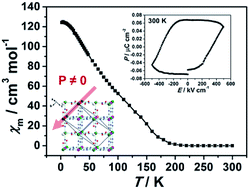A breakthrough in the intrinsic multiferroic temperature region in Prussian blue analogues†
Abstract
Thin films of [(FeIIxCrII1−x)]1.5[CrIII(CN)6]·yH2O (x ≈ 0.30–0.35, y ≈ 1.77) (1) on FTO substrates (namely film 1) were synthesized with an electrochemical method. Investigation of the ferroelectricity of film 1 at different temperatures reveals that it exhibits ferroelectric behaviour in the temperature range from 10 K to 310 K. Study of the X-ray absorption (XAS) of the crushed film 1 and simulation of the structure of film 1 and crushed film 1 by using the Materials Studio software indicate that the vacancy defects and interactions between the film and FTO substrate make a key contribution to the ferroelectricity of film 1. Owing to the magnetic phase transition point being up to 210 K, film 1 is a multiferroic material and its magneto/electric coexistence temperature can be as high as 210 K.



 Please wait while we load your content...
Please wait while we load your content...